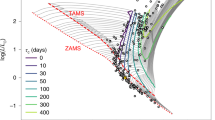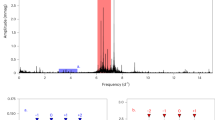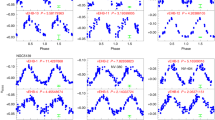Abstract
Unlike partially convective stars such as the Sun, fully convective stars do not possess a radiative core. Whether a star needs this core to generate a solar-like magnetic dynamo is still unclear. Recent studies suggest fully and partially convective stars exhibit very similar period–activity relationships, hinting that dynamos generated by stars with and without radiative cores hold similar properties. Here, using kinematic ages, we discover an abrupt change in the stellar spin-down law across the fully convective boundary. We found that fully convective stars exhibit a higher angular momentum loss rate, corresponding to a torque that is ~1.51 times higher for a given angular velocity than partially convective stars around the fully convective boundary. Because stellar-wind torques depend primarily on large-scale magnetic fields and mass-loss rates, both of which are suggested to be similar for partially and fully convective stars, the observed abrupt change in spin-down law suggests that the dynamos of partially and fully convective stars may be fundamentally different.
This is a preview of subscription content, access via your institution
Access options
Access Nature and 54 other Nature Portfolio journals
Get Nature+, our best-value online-access subscription
$29.99 / 30 days
cancel any time
Subscribe to this journal
Receive 12 digital issues and online access to articles
$119.00 per year
only $9.92 per issue
Buy this article
- Purchase on Springer Link
- Instant access to full article PDF
Prices may be subject to local taxes which are calculated during checkout



Similar content being viewed by others
Data availability
The data used are available in Supplementary Data 1.
References
Chabrier, G. & Baraffe, I. Structure and evolution of low-mass stars. Astron. Astrophys. 327, 1039–1053 (1997).
Pallavicini, R. et al. Relations among stellar X-ray emission observed from Einstein, stellar rotation and bolometric luminosity. Astrophys. J. 248, 279–290 (1981).
Lehtinen, J. J., Spada, F., Käpylä, M. J., Olspert, N. & Käpylä, P. J. Common dynamo scaling in slowly rotating young and evolved stars. Nat. Astron. 4, 658–662 (2020).
Stelzer, B., Damasso, M., Scholz, A. & Matt, S. P. A path towards understanding the rotation-activity relation of M dwarfs with K2 mission, X-ray and UV data. Mon. Not. R. Astron. Soc. 463, 1844–1864 (2016).
Newton, E. R. et al. The Hα emission of nearby M dwarfs and its relation to stellar rotation. Astrophys. J. 834, 85 (2017).
Wright, N. J. et al. The stellar rotation-activity relationship in fully convective M dwarfs. Mon. Not. R. Astron. Soc. 479, 2351–2360 (2018).
Babcock, H. W. The topology of the Sun’s magnetic field and the 22-year cycle. Astrophys. J. 133, 572 (1961).
Leighton, R. B. A magneto-kinematic model of the solar cycle. Astrophys. J. 156, 1–26 (1969).
Cameron, R. H. & Schüssler, M. An update of Leighton’s solar dynamo model. Astron. Astrophys. 599, A52 (2017).
Warnecke, J. et al. Investigating global convective dynamos with mean-field models: full spectrum of turbulent effects required. Astrophys. J. Lett. 919, L13 (2021).
Matt, S. P. et al. The mass-dependence of angular momentum evolution in Sun-like stars. Astrophys. J. Lett. 799, L23 (2015).
Saders, J. L. et al. Weakened magnetic braking as the origin of anomalously rapid rotation in old field stars. Nature 529, 181–184 (2016).
Garraffo, C. et al. The revolution revolution: magnetic morphology driven spin-down. Astrophys. J. 862, 90 (2018).
Spada, F. & Lanzafame, A. C. Competing effect of wind braking and interior coupling in the rotational evolution of solar-like stars. Astron. Astrophys. 636, A76 (2020).
Irwin, J. et al. On the angular momentum evolution of fully convective stars: rotation periods for field M-dwarfs from the MEarth transit survey. Astrophys. J. 727, 56 (2011).
Berta, Z. K. et al. Transit detection in the MEarth survey of nearby M dwarfs: bridging the clean-first, search-later divide. Astrophys. J. 144, 145 (2012).
Dungee, R. et al. A 4 Gyr M-dwarf gyrochrone from CFHT/MegaPrime monitoring of the open cluster M67. Astrophys. J. 938, 118 (2022).
Lu, Y. et al. Bridging the gap—the disappearance of the intermediate period gap for fully convective stars, uncovered by new ZTF rotation periods. Astrophys. J. 164, 251 (2022).
Angus, R. et al. Exploring the evolution of stellar rotation using galactic kinematics. Astrophys. J. 160, 90 (2020).
Lu, Y. et al. Gyro-kinematic ages for around 30,000 Kepler stars. Astrophys. J. 161, 189 (2021).
Andrae, R., Rix, H.-W. & Chandra, V. Robust data-driven metallicities for 175 million stars from Gaia XP spectra. Astrophys. J. Suppl. Ser. 267, 8 (2023).
Siess, L., Dufour, E. & Forestini, M. An internet server for pre-main sequence tracks of low- and intermediate-mass stars. Astron. Astrophys. 358, 593–599 (2000).
Amard, L. et al. First grids of low-mass stellar models and isochrones with self-consistent treatment of rotation. From 0.2 to 1.5 M⊙ at seven metallicities from PMS to TAMS. Astron. Astrophys. 631, A77 (2019).
Saders, J. L. & Pinsonneault, M. H. An 3He-driven instability near the fully convective boundary. Astrophys. J. 751, 98 (2012).
Jao, W.-C., Henry, T. J., Gies, D. R. & Hambly, N. C. A gap in the lower main sequence revealed by Gaia data release 2. Astrophys. J. Lett. 861, L11 (2018).
Gaia Collaboration et al. Gaia data release 2. Summary of the contents and survey properties. Astron. Astrophys. 616, A1 (2018).
Feiden, G. A., Skidmore, K. & Jao, W.-C. Gaia gaps and the physics of low-mass stars. I. The fully convective boundary. Astrophys. J. 907, 53 (2021).
Baraffe, I. & Chabrier, G. A closer look at the transition between fully convective and partly radiative low-mass stars. Astron. Astrophys. 619, A177 (2018).
Foreman-Mackey, D., Hogg, D. W., Lang, D. & Goodman, J. emcee: the MCMC hammer. Publ. Astron. Soc. Pac. 125, 306 (2013).
Curtis, J. L. et al. When do stalled stars resume spinning down? Advancing gyrochronology with Ruprecht 147. Astrophys. J. 904, 140 (2020).
Mestel, L. Angular momentum loss during pre-main sequence contraction. in Cool Stars, Stellar Systems, and the Sun. Lecture Notes in Physics (eds Baliunas, S. L. & Hartmann, L.) Vol. 193, 49 (Springer, Berlin, Heidelberg, 1984).
Finley, A. J. & Matt, S. P. The effect of combined magnetic geometries on thermally driven winds. II. Dipolar, quadrupolar, and octupolar topologies. Astrophys. J. 854, 78 (2018).
Wood, B. E. et al. New observational constraints on the winds of M dwarf stars. Astrophys. J. 915, 37 (2021).
See, V., Lehmann, L., Matt, S. P. & Finley, A. J. How much do underestimated field strengths from Zeeman–Doppler imaging affect spin-down torque estimates? Astrophys. J. 894, 69 (2020).
Kochukhov, O. & Shulyak, D. Magnetic field of the eclipsing M-dwarf binary YY Gem. Astrophys. J. 873, 69 (2019).
Green, G. M. dustmaps: a Python interface for maps of interstellar dust. J. Open Source Softw. 3, 695 (2018).
Green, G. M. et al. Galactic reddening in 3D from stellar photometry—an improved map. Mon. Not. R. Astron. Soc. 478, 651–666 (2018).
Yu, J. & Liu, C. The age-velocity dispersion relation of the Galactic discs from LAMOST-Gaia data. Mon. Not. R. Astron. Soc. 475, 1093–1103 (2018).
Lu, Y., Angus, R., Foreman-Mackey, D. & Hattori, S. In this day and age: an empirical gyrochronology relation for partially and fully convective single field stars. Preprint at https://arxiv.org/abs/2310.14990 (2023).
Borucki, W. J. et al. Kepler planet-detection mission: introduction and first results. Science 327, 977–980 (2010).
Bellm, E. C. et al. The Zwicky Transient Facility: system overview, performance, and first results. Publ. Astron. Soc. Pac. 131, 018002 (2019).
Collaboration, G. Gaia data release 3: summary of the content and survey properties. Astron. Astrophys. 674, A1 (2023).
Collaboration, A. Astropy: a community Python package for astronomy. Astron. Astrophys. 558, A33 (2013).
Price-Whelan, A. M. et al. The Astropy project: building an open-science project and status of the v2.0 core package. Astrophys. J. 156, 123 (2018).
Asplund, M., Amarsi, A. M. & Grevesse, N. The chemical make-up of the Sun: a 2020 vision. Astron. Astrophys. 653, A141 (2021).
Krishna Swamy, K. S. Profiles of strong lines in K-dwarfs. Astrophys. J. 145, 174–194 (1966).
Pordes, R. et al. The open Science grid. J. Phys. Conf. Ser. 78, 012057 (2007).
Sfiligoi, I. et al. The pilot way to grid resources using glideinWMS. In 2009 WRI World Congress on Computer Science and Information Engineering Vol. 2, 428–432 (IEEE, 2009).
Ochsenbein, F., Bauer, P. & Marcout, J. The VizieR database of astronomical catalogues. Astron. Astrophys. Suppl. 143, 23–32 (2000).
Wenger, M. et al. The SIMBAD astronomical database. The CDS reference database for astronomical objects. Astron. Astrophys. Suppl. 143, 9–22 (2000).
Skumanich, A. Time scales for CA II emission decay, rotational braking, and lithium depletion. Astrophys. J. 171, 565–567 (1972).
Acknowledgements
Y.L. acknowledges support from the the European Space Agency (ESA) through the Science Faculty of the European Space Research and Technology Centre (ESTEC). V.S. acknowledges support from the ESA as an ESA Research Fellow. R.A. acknowledges support from NSF AAG grant no. 2108251. S.P.M. acknowledges support as a visiting scholar from the Center for Computational Astrophysics at the Flatiron Institute, which is supported by the Simons Foundation. This work has made use of data from the ESA mission Gaia, processed by the Gaia Data Processing and Analysis Consortium (DPAC). Funding for the DPAC has been provided by national institutions, in particular, the institutions participating in the Gaia Multilateral Agreement. This research also made use of public auxiliary data provided by ESA/Gaia/DPAC/CU5 and prepared by Carine Babusiaux. This research was done using services provided by the OSG Consortium47,48, which is supported by the National Science Foundation award nos. 2030508 and 1836650. This research has also made use of NASA’s Astrophysics Data System and the VizieR49 and SIMBAD50 databases, operated at CDS, Strasbourg, France.
Author information
Authors and Affiliations
Contributions
Y.L. developed the initial idea and prepared the observational data. L.A. prepared the stellar evolution model. Y.L., V.S., L.A. and R.A. conducted the data analysis. Y.L., V.S., L.A., R.A. and S.P.M. interpreted the broader context and wrote the manuscript.
Corresponding author
Ethics declarations
Competing interests
The authors declare no competing interests.
Peer review
Peer review information
Nature Astronomy thanks Maarit Korpi-Lagg and the other, anonymous, reviewer(s) for their contribution to the peer review of this work.
Additional information
Publisher’s note Springer Nature remains neutral with regard to jurisdictional claims in published maps and institutional affiliations.
Supplementary information
Supplementary Information
Supplementary Fig. 1.
Supplementary Data 1
The raw data used to generate the figures in the main text. The second row describes each column, and the units are in brackets
Rights and permissions
Springer Nature or its licensor (e.g. a society or other partner) holds exclusive rights to this article under a publishing agreement with the author(s) or other rightsholder(s); author self-archiving of the accepted manuscript version of this article is solely governed by the terms of such publishing agreement and applicable law.
About this article
Cite this article
Lu, Y.(., See, V., Amard, L. et al. An abrupt change in the stellar spin-down law at the fully convective boundary. Nat Astron 8, 223–229 (2024). https://doi.org/10.1038/s41550-023-02126-2
Received:
Accepted:
Published:
Issue Date:
DOI: https://doi.org/10.1038/s41550-023-02126-2
This article is cited by
-
Observationally Guided Models for the Solar Dynamo and the Role of the Surface Field
Space Science Reviews (2023)



